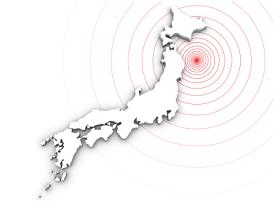 It is still too early to estimate with much precision the quantitative impacts of the devastating events in Japan on the global energy sector, as well as the effects on energy and economic activity in Japan. Nevertheless, some qualitative conclusions can be drawn about the near and medium effects on Japanese and global energy balances. Much more difficult and speculative are judgments about the effect of the nuclear accident that resulted from the natural disaster on the longer-term energy picture.
It is still too early to estimate with much precision the quantitative impacts of the devastating events in Japan on the global energy sector, as well as the effects on energy and economic activity in Japan. Nevertheless, some qualitative conclusions can be drawn about the near and medium effects on Japanese and global energy balances. Much more difficult and speculative are judgments about the effect of the nuclear accident that resulted from the natural disaster on the longer-term energy picture.
Japan’s pre-disaster energy balances and the immediate effects of the crisis. In 2009, 1046 terawatt-hours (TWh) of electricity were generated in Japan. Generation was 28% coal-fired, 27% nuclear, 26% gas [almost entirely sourced from liquefied natural gas (LNG)], 9% oil, 8% hydro, and 2% biomass. Non-hydro renewables contribute a negligible share, although this segment has been growing in recent years.
Oil provides a higher share of total primary energy in Japan, compared to other OECD countries1. In 2010, Japan was the third largest net importer of crude oil (4.3 million barrels per day) and the largest importer of both LNG (192 thousand tons per day) and coal (343 thousand tons per day). Japan has had longstanding initiatives for improving energy efficiency, motivated particularly to reduce its energy import costs. These initiatives have acted to reduce the oil-intensity of the economy, and this also has reduced the absolute volume of oil imports by a few percent per year since Japanese GDP has been stagnant for some time.
Around 9.7 GW of nuclear plant capacity (out of a total of 48 GW) was shut down because of the earthquake2. Under normal operating conditions in Japan, the lost nuclear capacity would generate approximately 60 TWh of electricity annually. Some 9.5 GW of coal, gas, and oil-fired capacity also was shut down. These disruptions in electricity supply have led to the widely reported occurrences of rolling blackouts in some parts of the country, with adverse effects on the population and the economy. However, we think it is reasonable to suppose the disrupted coal, oil, and gas-fired capacity will come back online fairly quickly – certainly much faster than the nuclear capacity, some of which appears non-recoverable.
The immediate effects of the crisis on the Japanese economy have been negative, as one would expect, though prognoses as to the size and duration of these effects have varied considerably and more time is needed to establish better estimates. One effect of a slowdown in Japanese economic activity is reduced pressure on existing generation capacity, though in the near term the proportional drop in electricity demand will be significantly smaller than the proportional drop in economic activity. Globally, a near-term reduction in fossil-fueled generation from damages to Japanese plants will reduce marginally global demands for fossil fuels. This would keep fossil energy prices a bit lower than they might otherwise have been over the nearer term, though by how much and how long also are uncertain at this stage. Any near term decline in oil demand, along with the release of oil from Japan’s strategic reserves, has some dampening effect on world oil prices, though the quantities involved are small relative to global oil demand. In addition, the oil market has remained quite volatile in the face of a number of other factors, making it difficult to empirically identify the impacts from Japan.
Outlook for recovery of Japanese generation capacity. Relatively low capacity utilization rates in Japanese fossil-fired generation plants makes it easier to offset the impacts of the lost nuclear capacity relatively quickly, though damages to fossil plants will slow the adjustment somewhat. Utilization rates of installed electricity generating capacity generally are low in Japan relative to other developed countries. Utilization rates are especially low for oil-fired plants, reflecting their role as reserve capacity. In 2009, oil-fired plants had an average utilization rate of around 30% and generated around 100 TWh of electricity. Making up for the roughly 60 TWh shortfall created by the loss of nuclear generation capacity would require increasing the near-term utilization rate for oil plants to 48%, even if one makes the extreme assumption of no increase in utilization rates for gas or coal fired fossil generation capacity and one ignores nearer-term decline in electricity demand from the shocks to the economy. In our judgment this should be feasible, although it would be costly – and it would depend on decisions by economic and environmental regulators to allow a ramp-up in oil capacity utilization. The existence of a highly liquid global spot market for oil means that there would be no serious constraints to obtaining the needed increases in oil imports.
Prior to the crisis, Japan also had some room to increase utilization rates for gas and coal fired generating capacity. Increasing the utilization of this capacity would dampen nearer-term effects on total electricity supply from the abovementioned damages to some gas and coal-fired plants. It also offers additional means to help offset the effects of the nuclear outages – at least in the medium term, once damaged gas and coal fired capacity is restored. Nearer-term expansion of gas and coal- fired plants also depends on securing additional fuel supplies. Coal and LNG are sold under longer-term contracts, which might constrain expansion of coal and gas-fired generation in the short-run3. However, given the high cost of oil-fired generation, there is likely to be a shift towards natural gas and coal – though again, the amounts would depend on economic and environmental regulatory decisions.
Although there is significant spare generation capacity nationally, a significant portion of it is located in the southern part of the country where the grid operates at a different frequency than the northern system (including the Tokyo area) (60 hertz in the south, versus 50 hertz in the north). Total interconnection capacity between the two systems is currently around 1000 MW. Limits on capacity to transform the power frequency would constrain electricity exports from the southern system. As a result, electricity shortages could persist for some months, especially during the peak summer months.
Impacts on Japanese and global energy markets. The substitutions in generation capacity described above will increase Japan’s costs of generation and total expenditures for power; but impacts on world energy markets likely will be quite small. Even if the capacity shortfall induced by the shutdown of the nuclear plants were entirely met with oil-fired generation, some initial calculations suggest that the country would need to import approximately 280,000 additional barrels of oil per day4. This is an increase of 6% over Japan’s current oil imports. However, given that in 2010 global oil demand was 88 million barrels per day, Japan’s additional oil requirements would represent an increase of just 0.3% in global demand. Thus, expanded oil imports by Japan should not in and of themselves have a significant impact on the price of oil over any significant period of time. With high volatility in oil markets from a number of geopolitical as well as economic uncertainties, moreover, it will be difficult to identify the impacts on world oil prices of a small increase in Japanese imports, relative to other influences.
Other calculations suggest that beyond the immediate crisis, if the nuclear capacity shortfall was met with either gas-or coal-fired generation in order to limit the high cost of increased oil imports, Japan would need to import an additional 8 million tons of LNG, or an additional 20 million tons of coal per year, or some combination. In 2009 around 170 million tons of LNG were globally traded, while in 2010, 690 million tons of thermal coal were globally traded. Since the global market for LNG tanker capacity is tight, additional LNG demands from Japan could induce some nearer-term market pressures. On the other hand, there appears to be considerable excess supply of LNG at the field level as a consequence of the global recession over the past two years. Japan’s more serious limit to expanding LNG use might be constraints in LNG terminal capacity, which in turn could force the country to maintain reliance on increased utilization of oil-fired capacity for a longer period.
The nuclear question. The unfolding crisis associated with the damage to the Fukushima facility is leading to a reassessment of nuclear programs in many countries. So far, 32 countries have declared that they will continue with their nuclear programs while 10 have put them on hold. At this stage, the implications for nuclear energy over the longer term remain quite uncertain.
How this ultimately plays out will have major consequences for the long-term global energy balance, and for future greenhouse gas emissions. This can be illustrated with projections done by the International Energy Agency (IEA). In the IEA’s “Current Policies” scenario, global nuclear capacity is projected to grow from 391 GW in 2008 to 535 GW in 2030. Projections incorporating much tougher global greenhouse gas emissions limits incorporate a further 225 GW of nuclear capacity to the mix5. The scenarios also incorporate major increases in other types of low-carbon energy resources, as well as sharp increases in energy efficiency.
Participants in energy and climate change policy debates have strongly divergent views regarding the wisdom or realism of such scenarios for nuclear investment, but virtually everyone would agree that at the very least, the investment plans are quite ambitious within the envisaged time frame. By the same token, however, significantly reduced global deployment of nuclear power in the future would imply either a very undesirable further acceleration in the accumulation of greenhouse gas emissions in the atmosphere, or investments in other types of low-carbon energy resources on an even larger scale than is already envisaged in the IEA scenarios. In our view, such a massive scale-up of other low-carbon energy investments would be even more ambitious than the IEA investment scenarios.
1In 2008, oil accounted for 43% of total primary energy demand in Japan compared to an average of 38% for the OECD countries.
2These included: Fukushima I (Dai-Ichi) has six units with total capacity of 4546 GW (1x439, 4x760, 1x1067)--units 1, 2, 3 and 4 were damaged and units 5 and 6 experienced cooling problems; Fukushima II (Daini) has four units with total capacity of 4268 GW (4x1067)--units 1, 2, and 3 initially lost their reactor pressure suppression function; and Tokai Daini with capacity of 1060 GW. The three units at Onagawa with total capacity of 2090 GW were also shut down but their cooling systems have been reported to be operating normally.
3Russia, Indonesia and Qatar have all offered to supply Japan with LNG cargoes under long-term contract prices which should ease the expected price pressure in the spot market.
4This is a worst case scenario assuming that in addition to Fukushima I units which suffered substantial damage, the Fukushima II and the Tokai Daini units will also be off-line for an extended period of time. It also adjusts for the potentially lower thermal efficiency of oil fired plants in reserve.
5IEA (International Energy Agency). 2010. World Energy Outlook 2010. Paris: OECD



Join the Conversation